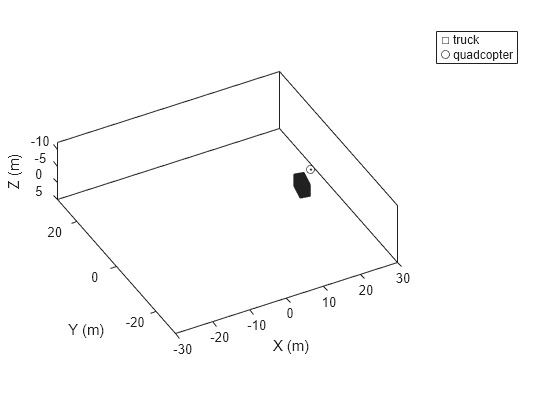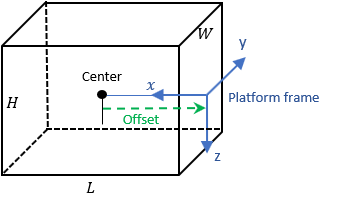platform
Description
Examples
Create a radar scenario.
rs = radarScenario;
Create a platform with default property values and add it to the scenario.
plat = platform(rs);
Specify the trajectory of the platform as a circular path of radius 10 m for one second. This is accomplished by placing waypoints in a circular shape, ensuring that the first and last waypoint are the same.
wpts = [0 10 0; 10 0 0; 0 -10 0; -10 0 0; 0 10 0]; times = [0; 0.25; .5; .75; 1.0]; plat.Trajectory = waypointTrajectory(wpts,times);
Display the properties of the platform object.
plat
plat =
Platform with properties:
PlatformID: 1
ClassID: 0
Position: [0 10 0]
Orientation: [-1.7180e-05 0 0]
Dimensions: [1×1 struct]
Trajectory: [1×1 waypointTrajectory]
PoseEstimator: [1×1 insSensor]
Emitters: {}
Sensors: {}
Signatures: {[1×1 rcsSignature]}
Perform the simulation, advancing one time step at a time. Display the simulation time and the position and velocity of the platform at each time step.
while advance(rs) p = pose(plat); disp(strcat("Time = ",num2str(rs.SimulationTime))) disp(strcat(" Position = [",num2str(p.Position),"]")) disp(strcat(" Velocity = [",num2str(p.Velocity),"]")) end
Time = 0
Position = [0 10 0]
Velocity = [62.8318 -1.88403e-05 0]
Time = 0.1
Position = [5.8779 8.0902 0]
Velocity = [50.832 -36.9316 0]
Time = 0.2
Position = [9.5106 3.0902 0]
Velocity = [19.4161 -59.7566 0]
Time = 0.3
Position = [9.5106 -3.0902 0]
Velocity = [-19.4161 -59.7567 0]
Time = 0.4
Position = [5.8779 -8.0902 0]
Velocity = [-50.832 -36.9316 0]
Time = 0.5
Position = [0 -10 0]
Velocity = [-62.8319 1.88181e-05 0]
Time = 0.6
Position = [-5.8779 -8.0902 0]
Velocity = [-50.832 36.9316 0]
Time = 0.7
Position = [-9.5106 -3.0902 0]
Velocity = [-19.4161 59.7566 0]
Time = 0.8
Position = [-9.5106 3.0902 0]
Velocity = [19.4161 59.7566 0]
Time = 0.9
Position = [-5.8779 8.0902 0]
Velocity = [50.832 36.9316 0]
Time = 1
Position = [-7.10543e-15 10 0]
Velocity = [62.8319 -1.88404e-05 0]
Create a radar scenario.
rs = radarScenario;
Create a cuboid platform for a truck with dimensions 5 m by 2.5 m by 3.5 m.
dim1 = struct('Length',5,'Width',2.5,'Height',3.5,'OriginOffset',[0 0 0]); truck = platform(rs,'Dimension',dim1);
Specify the trajectory of the truck as a circle with radius 20 m.
truck.Trajectory = waypointTrajectory('Waypoints', ... [20*cos(2*pi*(0:10)'/10) 20*sin(2*pi*(0:10)'/10) -1.75*ones(11,1)], ... 'TimeOfArrival',linspace(0,50,11)');
Create the platform for a small quadcopter with dimensions 0.3 m by 0.3 m by 0.1 m.
dim2 = struct('Length',.3,'Width',.3,'Height',.1,'OriginOffset',[0 0 0]); quad = platform(rs,'Dimension',dim2);
Specify the trajectory of the quadcopter as a circle 10 m above the truck with a small angular delay. Note that the negative z coordinates correspond to positive elevation.
quad.Trajectory = waypointTrajectory('Waypoints', ... [20*cos(2*pi*((0:10)'-.6)/10) 20*sin(2*pi*((0:10)'-.6)/10) -11.80*ones(11,1)], ... 'TimeOfArrival',linspace(0,50,11)');
Visualize the results using theaterPlot.
tp = theaterPlot('XLim',[-30 30],'YLim',[-30 30],'Zlim',[-12 5]); pp1 = platformPlotter(tp,'DisplayName','truck','Marker','s'); pp2 = platformPlotter(tp,'DisplayName','quadcopter','Marker','o');
Specify a view direction and run the simulation.
view(-28,37); set(gca,'Zdir','reverse'); while advance(rs) poses = platformPoses(rs); plotPlatform(pp1,poses(1).Position,truck.Dimensions,poses(1).Orientation); plotPlatform(pp2,poses(2).Position,quad.Dimensions,poses(2).Orientation); end

Input Arguments
Radar scenario, specified as a radarScenario
object.
Name-Value Arguments
Specify optional pairs of arguments as
Name1=Value1,...,NameN=ValueN, where Name is
the argument name and Value is the corresponding value.
Name-value arguments must appear after other arguments, but the order of the
pairs does not matter.
Before R2021a, use commas to separate each name and value, and enclose
Name in quotes.
Example: 'ClassID',2
Platform classification identifier, specified as a nonnegative integer. You can
define your own platform classification scheme and assign ClassID
values to platforms according to the scheme. The value of 0 is
reserved for an object of unknown or unassigned class.
Example: 5
Data Types: double
Platform motion, specified as a kinematicTrajectory object, a waypointTrajectory object, or a geoTrajectory object. The
trajectory object defines the time evolution of the position and velocity of the
platform frame origin, as well as the orientation of the platform frame relative to the
scenario frame.
When the
IsEarthCenteredproperty of the scenario is set tofalse, use thekinematicTrajectoryor thewaypointTrajectoryobject. By default, the platform uses a stationarykinematicTrajectoryobject.When the
IsEarthCenteredproperty of the scenario is set totrue, use thegeoTrajectoryobject. By default, the platform uses a stationarygeoTrajectoryobject.
This property is read-only.
Current position of the platform, specified as a three-element vector of scalars.
When the
IsEarthCenteredproperty of the scenario is set tofalse, the position is specified as a three-element Cartesian state [x,y,z] in meters.When the
IsEarthCenteredproperty of the scenario is set totrue, the position is specified as a three-element geodetic state:latitudein degrees,longitudein degrees, andaltitudein meters.
Specify this argument only when creating a stationary platform. If you choose to
specify the trajectory of the platform, use the Trajectory
argument.
Data Types: double
This property is read-only.
Orientation of the platform, specified as a three-element numeric vector in
degrees. The three elements are the [yaw, pitch,
roll] rotation angles from the local reference frame to the body
frame of the platform.
Specify this argument only when creating a stationary platform. If you choose to
specify the orientation over time, use the Trajectory argument.
Data Types: double
Platform signatures, specified as a cell array of signature objects or an empty
cell array ({}). The default value is a cell array containing an
rcsSignature
object with default property values. If you have Sensor Fusion and Tracking Toolbox™, then the cell array can also include irSignature (Sensor Fusion and Tracking Toolbox)
and tsSignature (Sensor Fusion and Tracking Toolbox)
objects. The cell array contains at most one instance for each type of signature
object. A signature represents the reflection or emission pattern of a platform such
as its radar cross-section, target strength, or IR intensity.
Platform dimensions and origin offset, specified as a structure. The structure contains the
Length, Width, Height, and
OriginOffset of a cuboid that approximates the dimensions of the
platform. The OriginOffset is the position vector from the center of
the cuboid to the origin of the platform coordinate frame. The
OriginOffset is expressed in the platform coordinate system. For
example, if the platform origin is at the center of the cuboid rear face as shown in the
figure, then set OriginOffset as [-L/2,
0, 0]. The default value for Dimensions is a structure
with all fields set to zero, which corresponds to a point model.

Fields of Dimensions
| Fields | Description | Default |
|---|---|---|
Length | Dimension of a cuboid along the x direction | 0 |
Width | Dimension of a cuboid along the y direction | 0 |
Height | Dimension of a cuboid along the z direction | 0 |
OriginOffset | Position of the platform coordinate frame origin with respect to the cuboid center | [0 0 0 ] |
Example: struct('Length',5,'Width',2.5,'Height',3.5,'OriginOffset',[-2.5 0 0])
For the
radarTransceiverplatformLength,Width, andHeightcan be set to any non-negative values when used in aradarScenario.For the
radarDataGenerator, platformLength,Width, andHeightare ignored if set to non-zero values in aradarScenario. All platforms are considered points.
Data Types: struct
Platform pose estimator, specified as a pose-estimator object such as an insSensor
object. The pose estimator determines platform pose with respect to the local NED
scenario coordinates. The interface of any pose estimator must match the interface of
the insSensor object. By default, the platform sets the pose
estimator accuracy properties to zero.
Emitters mounted on the platform, specified as a cell array of emitter objects
such as radarEmitter objects. If you have Sensor Fusion and Tracking Toolbox, then the cell array can also include sonarEmitter (Sensor Fusion and Tracking Toolbox) objects.
Sensors mounted on the platform, specified as a cell array of sensor objects such
as radarDataGenerator objects.
Output Arguments
Scenario platform, returned as a Platform
object.
Version History
Introduced in R2021a
See Also
Platform | radarScenario | waypointTrajectory | rcsSignature | insSensor | radarEmitter | radarDataGenerator
MATLAB Command
You clicked a link that corresponds to this MATLAB command:
Run the command by entering it in the MATLAB Command Window. Web browsers do not support MATLAB commands.
Select a Web Site
Choose a web site to get translated content where available and see local events and offers. Based on your location, we recommend that you select: .
You can also select a web site from the following list
How to Get Best Site Performance
Select the China site (in Chinese or English) for best site performance. Other MathWorks country sites are not optimized for visits from your location.
Americas
- América Latina (Español)
- Canada (English)
- United States (English)
Europe
- Belgium (English)
- Denmark (English)
- Deutschland (Deutsch)
- España (Español)
- Finland (English)
- France (Français)
- Ireland (English)
- Italia (Italiano)
- Luxembourg (English)
- Netherlands (English)
- Norway (English)
- Österreich (Deutsch)
- Portugal (English)
- Sweden (English)
- Switzerland
- United Kingdom (English)